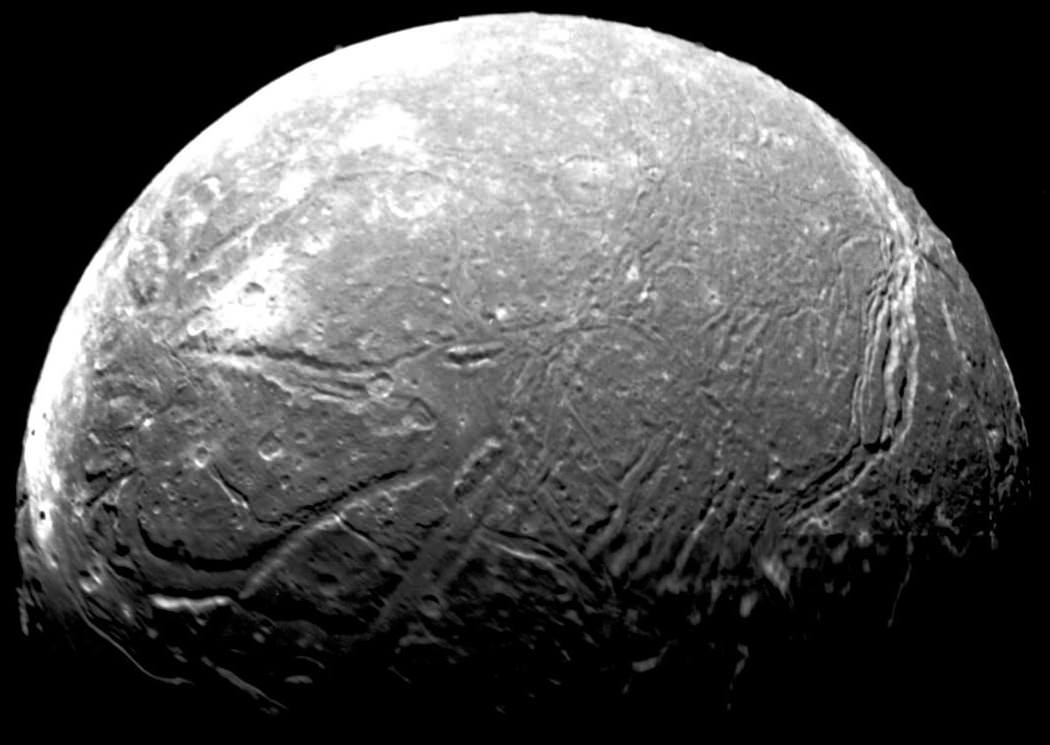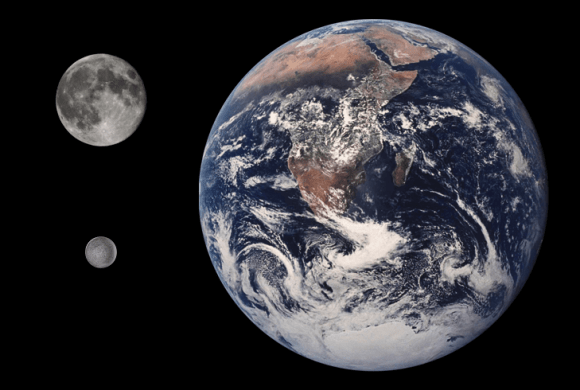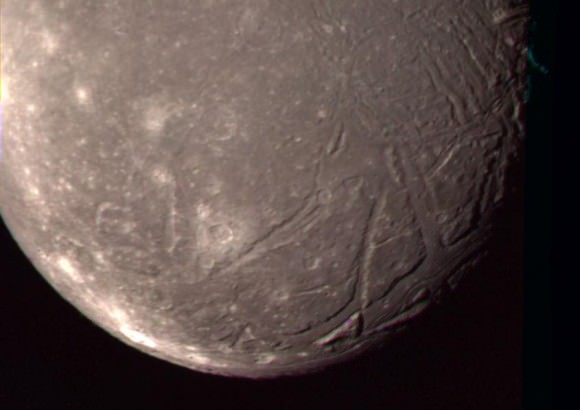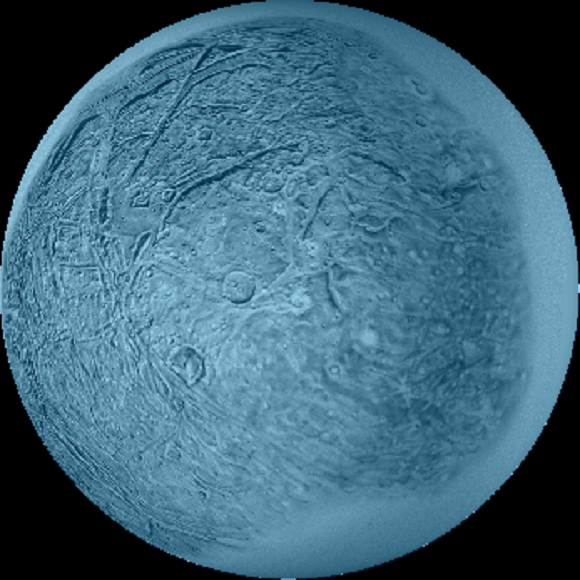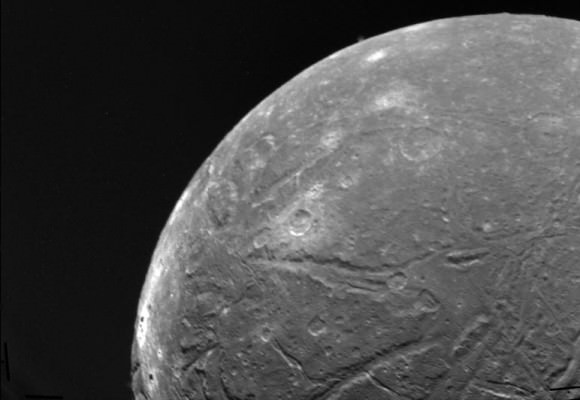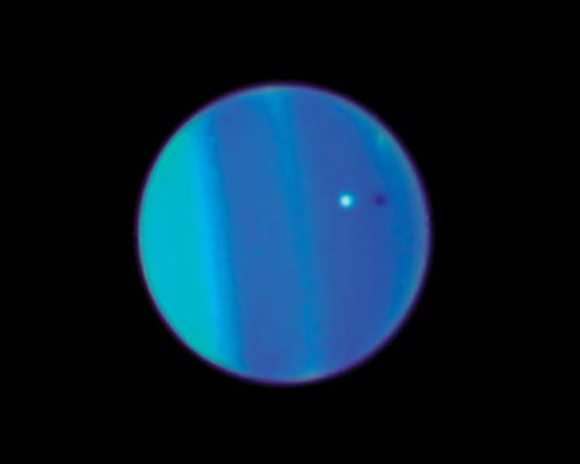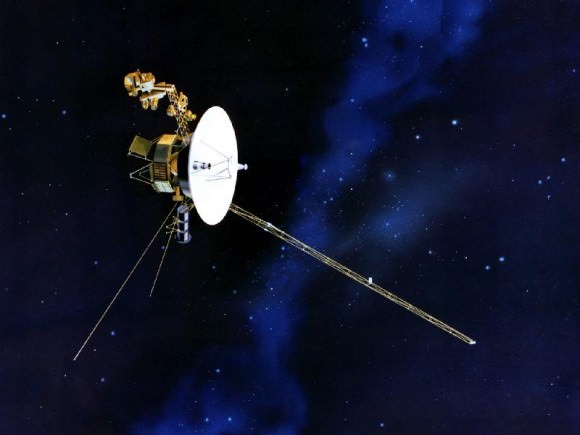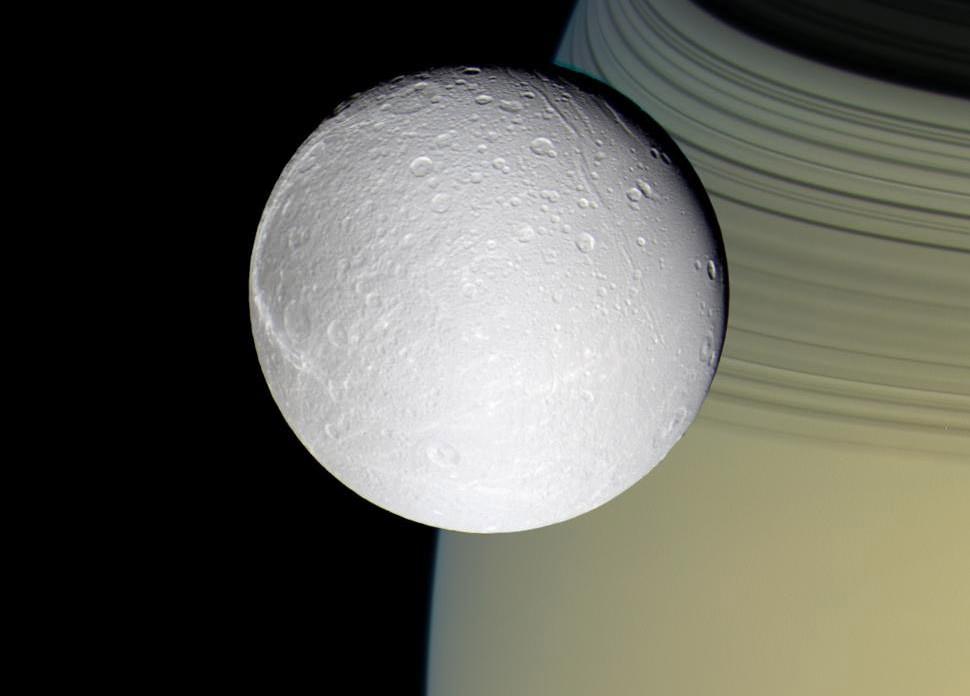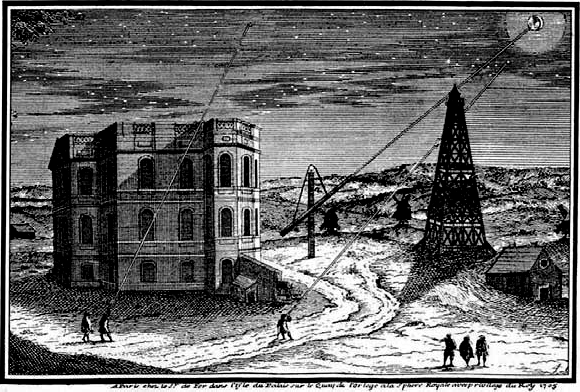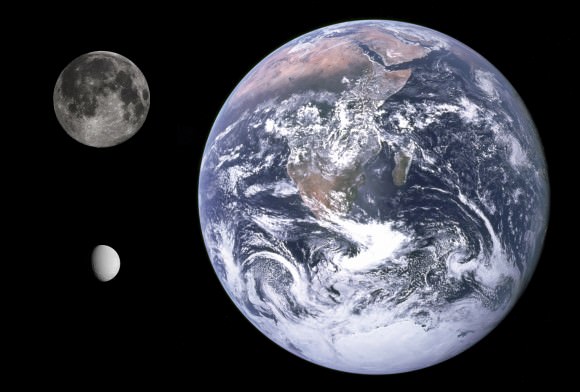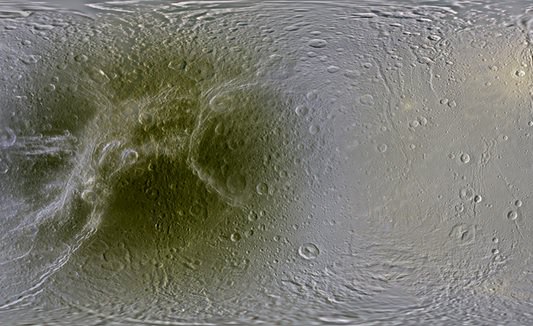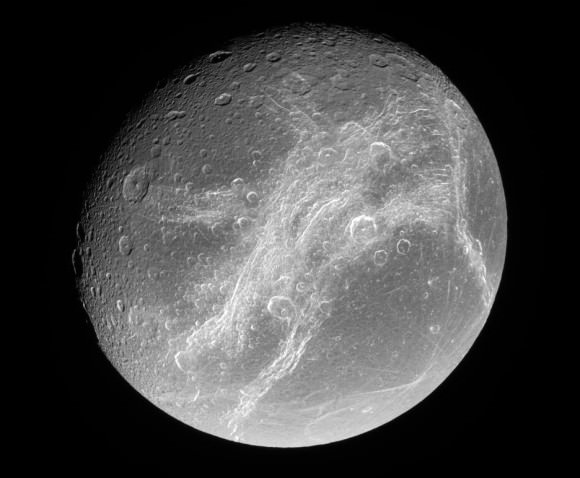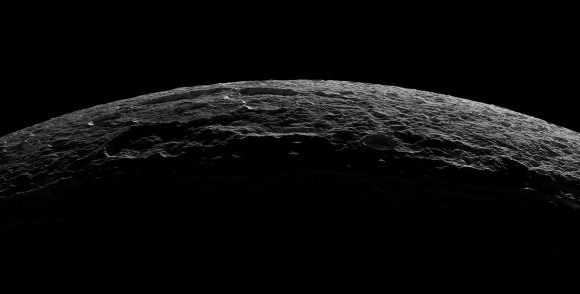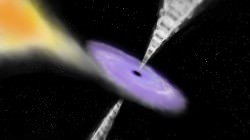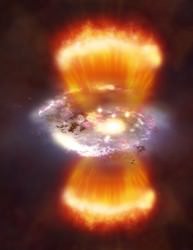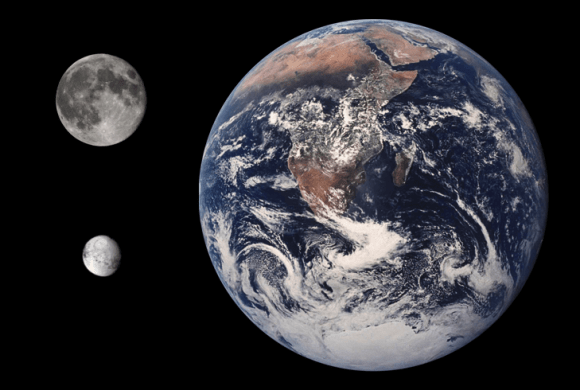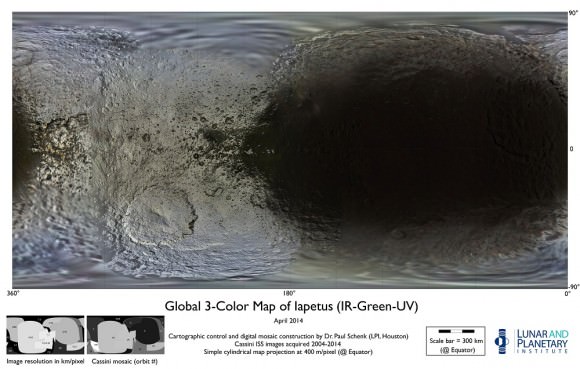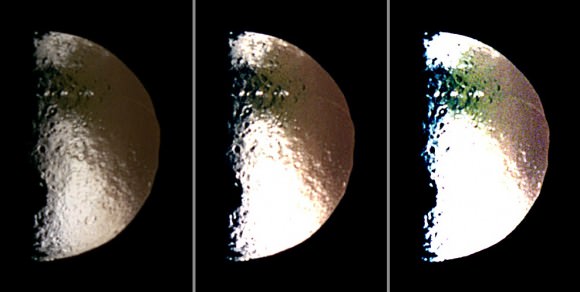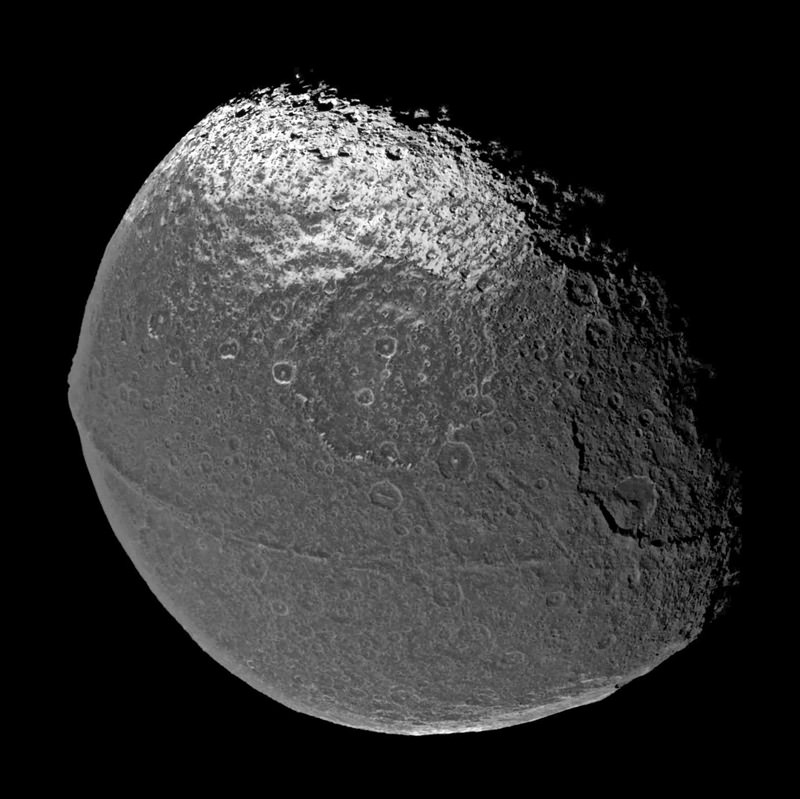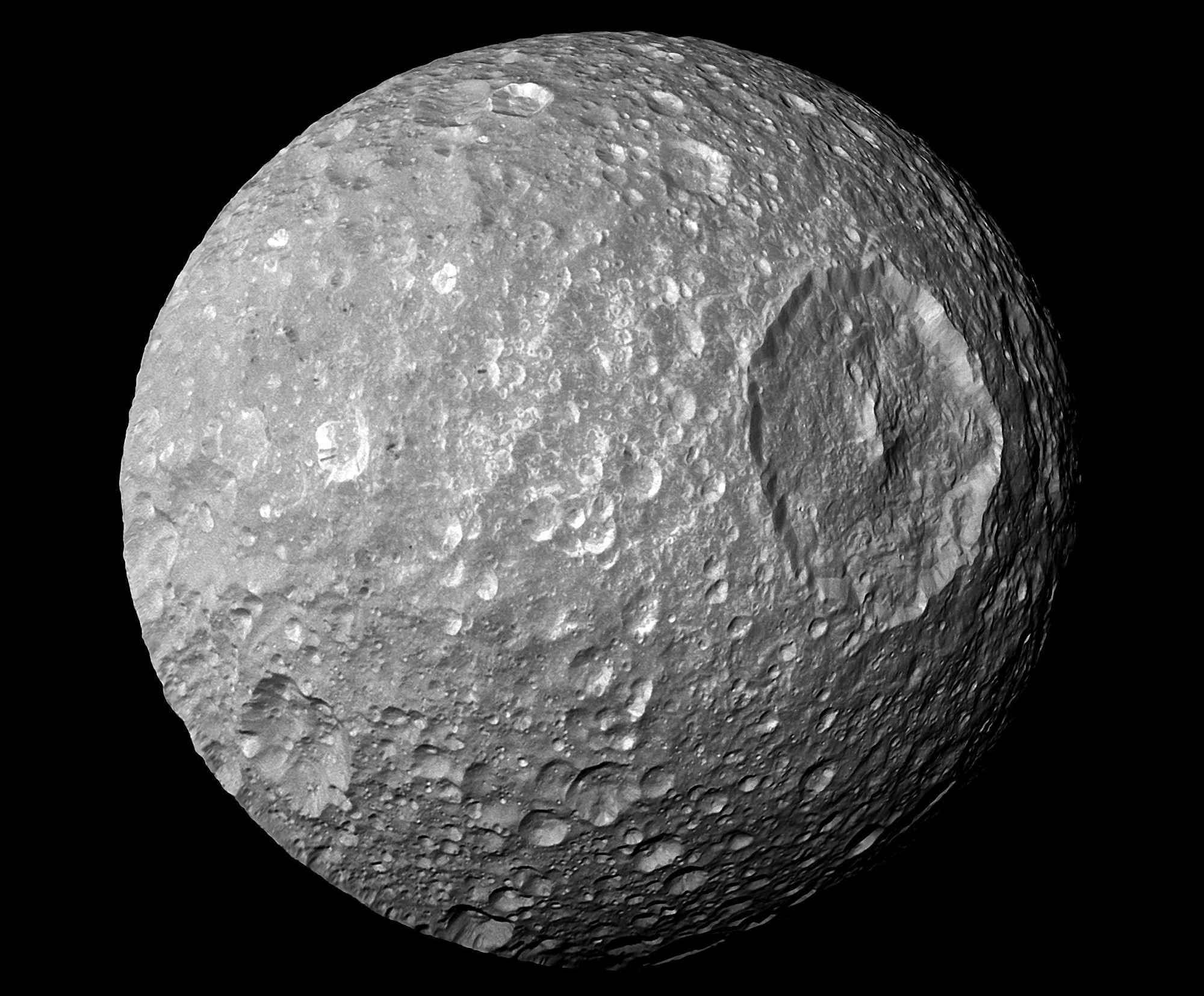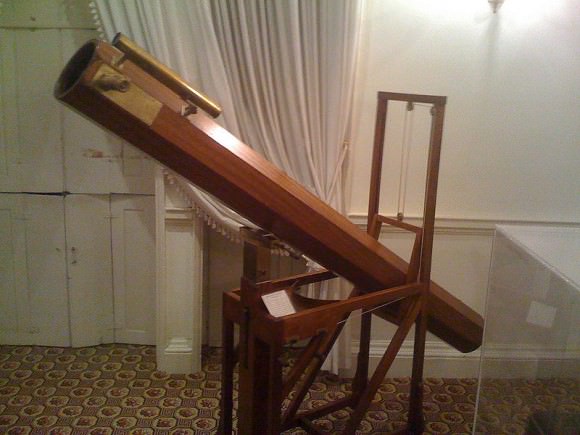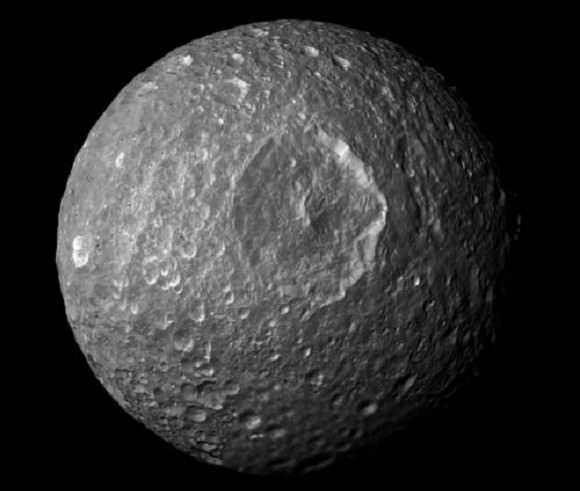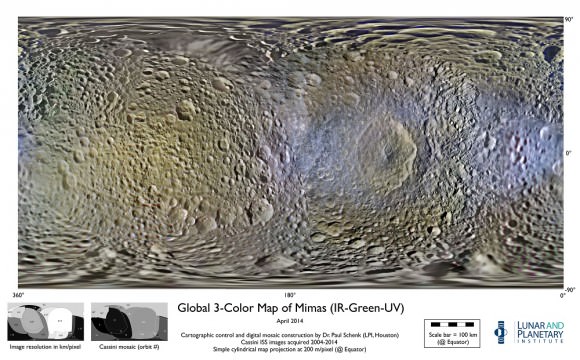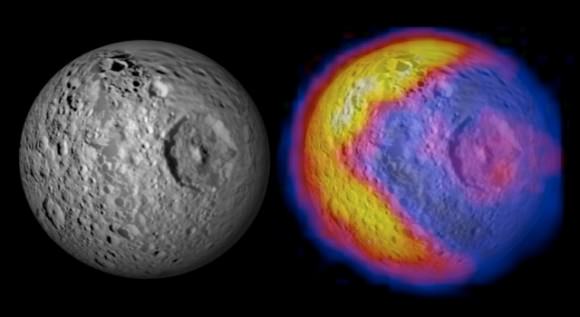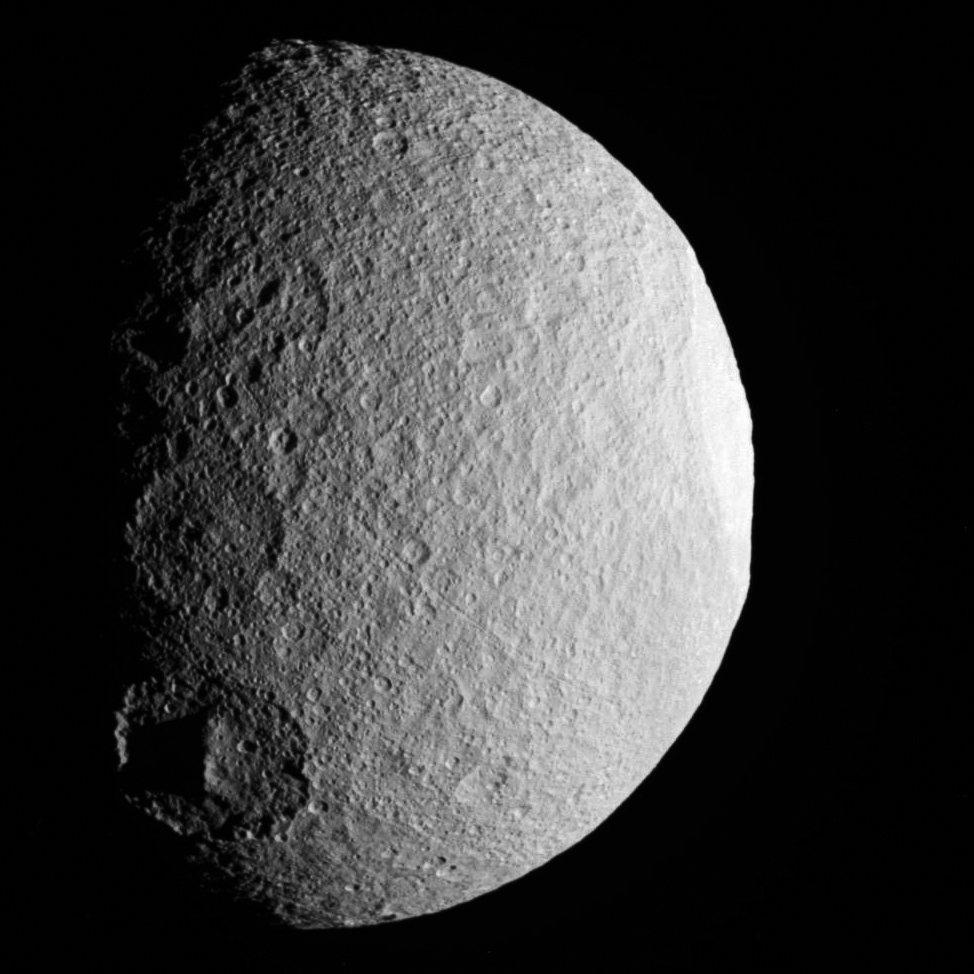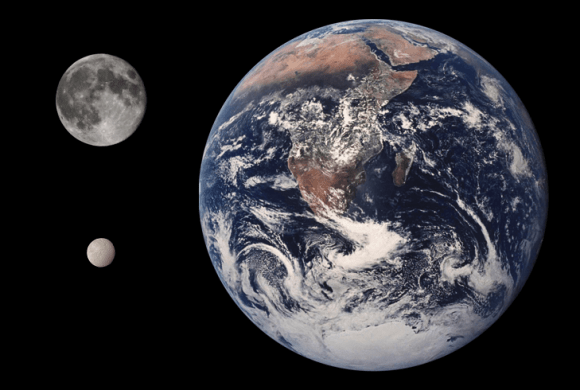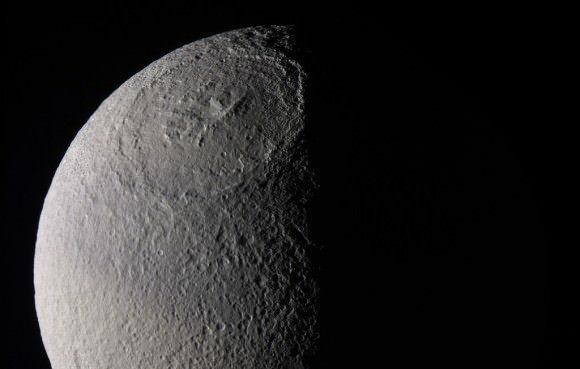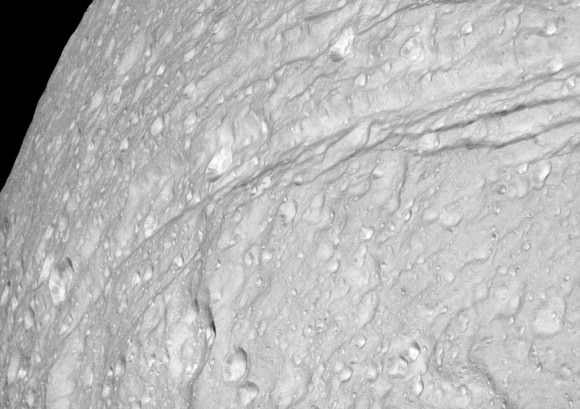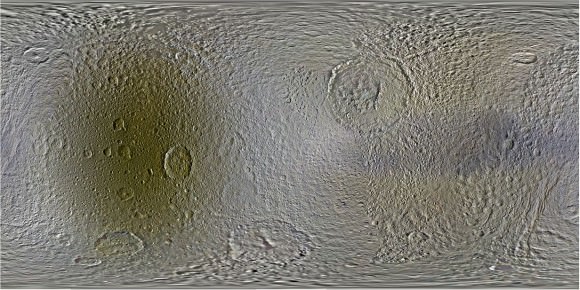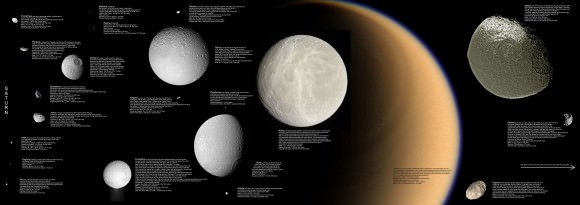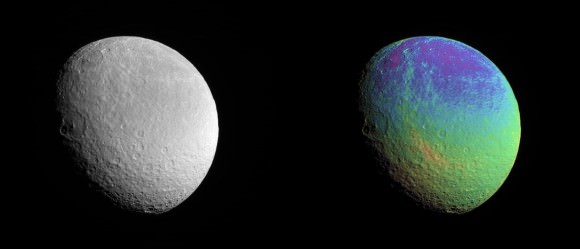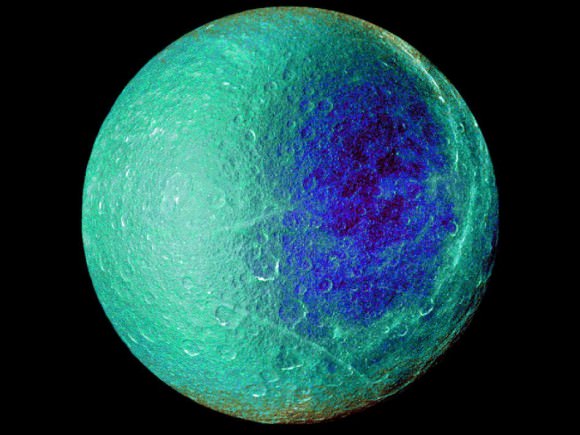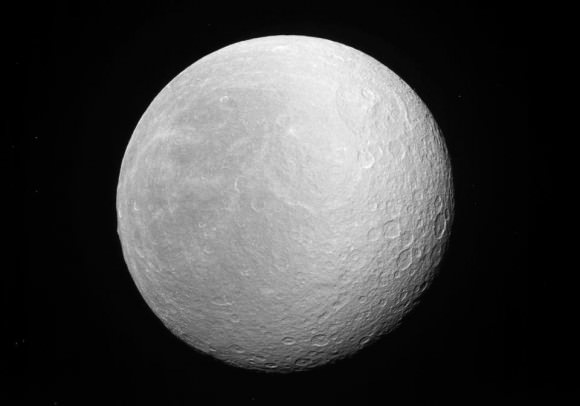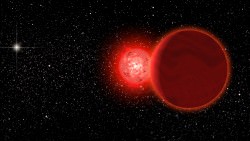Ever since the Voyager space probes ventured into the outer Solar System, scientists and astronomers have come to understand a great deal of this region of space. In addition to the four massive gas giants that call the outer Solar System home, a great deal has been learned about the many moons that circle them. And thanks to photographs and data obtained, human beings as a whole have come to understand just how strange and awe-inspiring our Solar System really is.
This is especially true of Miranda, the smallest and innermost of Uranus’ large moons – and some would say, the oddest-looking! Like the other major Uranian moons, its orbits close to its planet’s equator, is perpendicular to the Solar System’s ecliptic, and therefore has an extreme seasonal cycle. Combined with one of the most extreme and varied topographies in the Solar System, this makes Miranda an understandable source of interest!
Discovery and Naming:
Miranda was discovered on February 16th, 1948, by Gerard Kuiper using the McDonald Observatory‘s Otto Struve Telescope at the University of Texas in Austin. Its motion around Uranus was confirmed on March 1st of the same year, making it the first satellite of Uranus to be discovered in almost a century (the previous ones being Ariel and Umbriel, which were both discovered in 1851 by William Lassell).
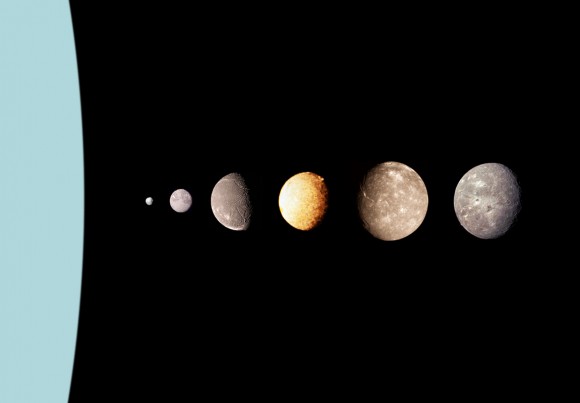
Consistent with the names of the other moons, Kuiper decided to the name the object “Miranda” after the character in Shakespeare’s The Tempest. This continued the tradition set down by John Herschel, who suggested that all the large moons of Uranus – Ariel, Umbriel, Titania and Oberon – be named after characters from either The Tempest or Alexander Pope’s The Rape of the Lock.
Size, Mass and Orbit:
With a mean radius of 235.8 ± 0.7 km and a mass of 6.59 ± 0.75 ×1019 kg, Miranda is 0.03697 Earths times the size of Earth and roughly 0.000011 as massive. Its modest size also makes it one of the smallest object in the Solar System to have achieved hydrostatic equilibrium, with only Saturn’s moon of Mimas being smaller.
Of Uranus’ five larger moons, Miranda is the closest, orbiting at an average distance (semi-major axis) of 129,390 km. It has a very minor eccentricity of 0.0013 and an inclination of 4.232° to Uranus’ equator. This is unusually high for a body so close to its parent planet – roughly ten times that of the other Uranian satellites.
Since there are no mean-motion resonances to explain this, it has been hypothesized that the moons occasionally pass through secondary resonances. At some point, this would have led Miranda into being locked in a temporary 3:1 resonance with Umbriel, and perhaps a 5:3 resonance with Ariel as well. This resonance would have altered the moon’s inclination, and also led to tidal heating in its interior (see below).
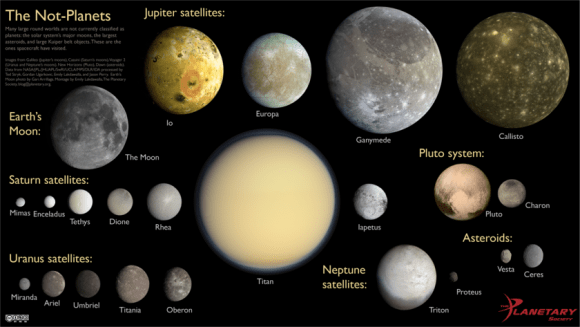
With an average orbital speed of 6.66 km/s, Miranda takes 1.4 days to complete a single orbit of Uranus. Its orbital period (also 34 hours) is synchronous with its rotational period, meaning that it is tidally-locked with Uranus and maintains one face towards it at all times. Given that it orbits around Uranus’ equator, which means its orbit is perpendicular to the Sun’s ecliptic, Uranus goes through an extreme seasonal cycle where the northern and southern hemispheres experience 42 years of lightness and darkness at a time.
Composition and Surface Structure:
Miranda’s mean density (1.2 g/cm3) makes it the least dense of the Uranian moons. It also suggests that Miranda is largely composed of water ice (at least 60%), with the remainder likely consisting of silicate rock and organic compounds in the interior. The surface of Miranda is also the most diverse and extreme of all moons in the Solar System, with features that appear to be jumbled together in a haphazard fashion.
This consists of huge fault canyons as deep as 20 km (12 mi), terraced layers, and the juxtaposition of old and young surfaces seemingly at random. This patchwork of broken terrain indicates that intense geological activity took place in Miranda’s past, which is believed to have been driven by tidal heating during the time when it was in orbital resonance with Umbriel (and perhaps Ariel).
This resonance would have increased orbital eccentricity, and along with varying tidal forces from Uranus, would have caused warming in Miranda’s interior and led to resurfacing. In addition, the incomplete differentiation of the moon, whereby rock and ice were distributed more uniformly, could have led to an upwelling of lighter material in some areas, thus leading to young and older regions existing side by side.
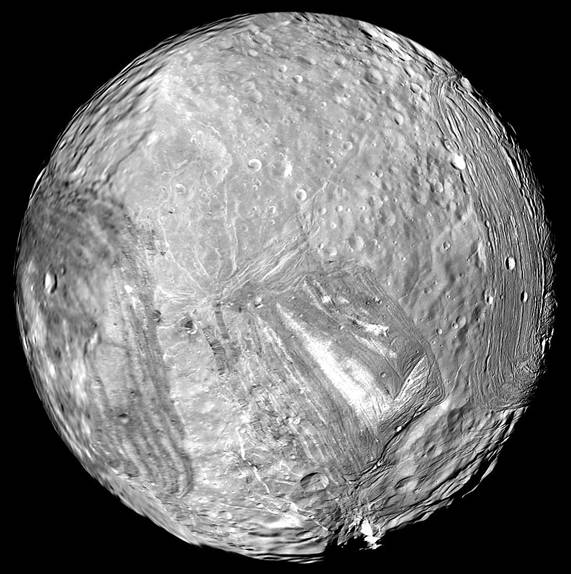
Another theory is that Miranda was shattered by a massive impact, the fragments of which reassembled to produce a fractured core. In this scenario – which some scientists believe could have happened as many as five times – the denser fragments would have sunk deep into the interior, with water ice and volatiles setting on top of them and mirroring their fractured shape.
Overall, scientists recognize five types of geological features on Miranda, which includes craters, coronae (large grooved features), regiones (geological regions), rupes (scarps or canyons) and sulci (parallel grooves).
Miranda’s cratered regions are differentiated between younger, lightly-cratered regions and older, more-heavily cratered ones. The lightly cratered regions include ridges and valleys, which are separated from the more heavily-cratered areas by sharp boundaries of mismatched features. The largest known craters are about 30 km (20 mi) in diameter, with others lying in the range of 5 to 10 km (3 to 6 mi).
Miranda has the largest known cliff in the Solar System, which is known as Verona Rupes (named after the setting of Shakespeare’s Romeo and Juliet). This rupes has a drop-off of over 5 km (3.1 mi) – making it 12 times as deep as the Grand Canyon. Scientists suspect that Miranda’s ridges and canyons represent extensional tilt blocks – a tectonic event where tectonic plates stretch apart, forming patterns of jagged terrain with steep drops.
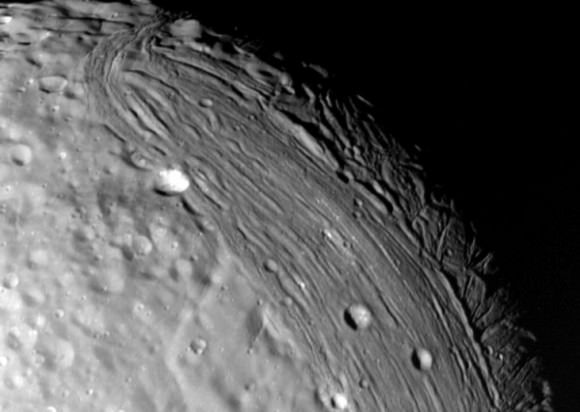
The most well known coronae exist in the southern hemisphere, with three giant ‘racetrack’-like grooved structures that measure at least 200 km (120 mi) wide and up to 20 km (12 mi) deep. These features, named Arden, Elsinore and Inverness – all locations in Shakespeare’s plays – may have formed via extensional processes at the tops of diapirs (aka. upwellings of warm ice).
Other features may be due to cryovolcanic eruptions of icy magma, which would have been driven by tidal flexing and heating in the past. With an albedo of 0.32, Miranda’s surface is nearly as bright as that of Ariel, the brightest of the larger Uranian moons. It’s slightly darker appearance is likely due to the presence of carbonaceous material within its surface ice.
Exploration:
Miranda’s apparent magnitude makes it invisible to many amateur telescopes. As a result, virtually all known information regarding its geology and geography was obtained during the only flyby of the Uranian system, which was made by Voyager 2 in 1986. During the flyby, Miranda’s southern hemisphere pointed towards the Sun (while the northern was shrouded in darkness), so only the southern hemisphere could be studied.
At this time, no future missions have been planned or are under consideration. But given Miranda’s “Frankenstein”-like appearance and the mysteries that still surround its history and geology, any future missions to study Uranus and its system of moons would be well-advised.
We have many interesting articles on Miranda and Uranus’ moons here at Universe Today. Here’s one about about why they call it the “Frankenstein Moon“, and one about Voyager 2‘s historic flyby. And here’s one that answers the question How Many Moons Does Uranus Have?
For more information, check out NASA’s Solar System Exploration page on Miranda.
Sources:


